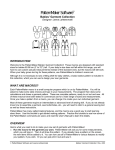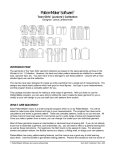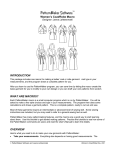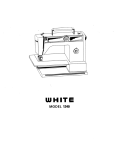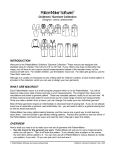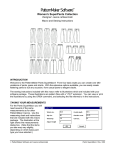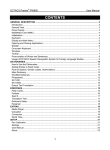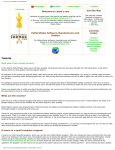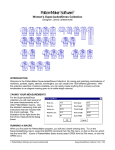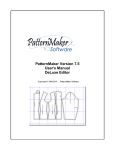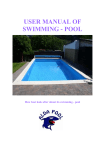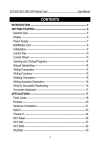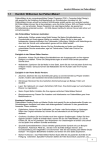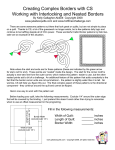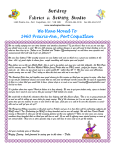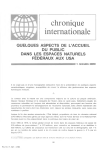Download Maternity - PatternMaker
Transcript
PatternMaker Software Maternity/Breastfeeding Garment Collection Designer: Leena Lahteenmaki INTRODUCTION Welcome to the PatternMaker Maternity/Breastfeeding Garment Collection! These macros are designed to take you all the way from the months of pregnancy through the period of breastfeeding. The maternity garments add extra ease to the front height and front width, while the breastfeeding garments have openings hidden under a front panel. The maternity garments can also be useful for a person with a very rounded abdomen who needs extra garment height in that area. WHAT ARE MACROS? Each PatternMaker macro is a small computer program which is run by PatternMaker. You will be asked to make some style choices and type in your measurements. The program then does some calculations and draws a garment pattern. These are complete patterns, ready to cut out and sew. All of these macros have been tested in commercial use for a wide range of sizes and measurements. Once you make a pattern from a macro, you can change it to create your own individual garment. Most of these garments require an intermediate or advanced level of sewing skill. If you do not already know how to assemble a garment, sew buttonholes, etc., you will need to refer to a general sewing text as well as these instructions. PatternMaker has many patternmaking features, and the macros are a good way to start learning about them. Use this booklet to get started making patterns. Practice the tutorials to see how some of the PatternMaker commands are used, and read the User’s Manual to learn the details. OVERVIEW Here’s what you need to do to make your new set of garments with PatternMaker: • Run the macro for the garment you want. PatternMaker will ask you for some measurements, which you will type in. Then it will draw the pattern. You can now use all of PatternMaker’s various features to modify your pattern, if you wish. Or you can just print it out and sew it. • Arrange for printing. You may need to use the MOVE and ROTATE commands to arrange the pieces for the most efficient printing. PatternMaker Software and Leena Lähteenmäki Maternity/Breastfeeding Collection Rev. 2/01 Maternity/Breastfeeding Collection • • Print your pattern. If you have a small desktop printer, you will need to tape the pages together. The pages will be marked to make it easy to assemble them. Cut out and sew your new garment. This booklet gives you most of the sewing instructions you need, but always rely on your common sense. We hope you enjoy your new clothes! MEASUREMENTS Waist circumference is not asked in the maternity macros. These garments have a loose waist construction. The macro estimates the waist circumference of maternity pants and skirt according to the hip circumference measurement, and the necessary amount of extra ease is added. In the dialog box, therefore, the amount of added front height and width is asked. The default values are 3cm/1.25" and 6cm/2.5" per pattern piece (i.e. 1/2 of the front piece). So, for example, 6cm/2.5" of added front width means that the estimated pattern waist circumference has been increased by 12cm/5". You can change these measurements according to the phase of your pregnancy or when sewing garments for a person with a round or tilted abdomen. To be sure that these values are okay, measure the abdomen circumference of the front and back patterns, multiply the measurement by 2 (because the patterns are 1/2 patterns). Compare this value to the circumference measurement of your abdomen. Remember that there is a handy measuring tool (Draw/Dim) in the PatternMaker editing tools which you can use to measure the patterns on screen. The circumference of the abdomen of the patterns must be 2-4cm/0.75-1.5" more than the abdomen circumference of your body. If you need to increase or decrease the amount of added ease on the abdomen level, change the added front width value in the measurements dialog box. If you need to add only a little (less than 5 cm/2"), don't change the added height value. If you need added width of more than 5cm/2" (in addition to the default 6 cm/2.5"), change the added front height value so that it is 1/31/4 of the added front width value. Do the fine adjustment when fitting the garment on. Note! Do not add anything to the body measurements when typing them in the measurements dialog box. The macro adds the needed wearing and design ease amounts in addition to the body measurements. For further adjustment possibilities, you can sew the skirt and pants using a hook-and-loop tape construction at the waistband. NOT-PREGNANT OPTION In most of the maternity macros there is a "not-pregnant-option". In garments meant for pregnant women extra ease has been added - not only to the waist circumference - but to front height, too. Otherwise the front hem would rise higher than the rest of the hem. 2 Maternity/Breastfeeding Collection The amount of ease added to the front height is determined by an average value, and may not work in all situations. Therefore, it is important that you check that the hem is parallel to the floor all around the garment when fitting the garment on. If you use the garment after your pregnancy, shorten the garment at the front hem, if needed. The bottom edges of the pockets have to be parallel to the hem. Therefore, do not fasten the pockets until you are sure that front height is OK and you can align pockets according to it. Hint : If you are sewing a garment for a person who is not pregnant, but has a round or tilted abdomen, choose "pregnant-option" and check that the hem is parallel to the floor when you try the garment on the subject. Straighten the front hem if needed. If you are not pregnant... You can type "0" (zero) as the added front width and/or height value. The result will then be patterns for normal pants or skirt. If you are not pregnant but have a round or tilted abdomen and you want to have extra ease at the abdomen area of the garment, check the correct amount of added front width and/or height by measuring the patterns and your body. Start with an added front width of "0" (zero) and added front height of 3cm/1.25". Measure the patterns and your body and change these values until you are satisfied with the abdomen width and height of the pattern. RUNNING A MACRO When you first start the PatternMaker program, you will see a blank drawing area. To run the macros, select the MACRO command from the File menu, or click on the icon which has the word MAC. (Users of PatternMaker Basic should select OPEN from the File menu, or click the OPEN icon.) A dialog box will ask you to select a file. Each macro is a separate file in your PatternMaker directory. Descriptions of each macro are given later in this book. The file names in this collection are: • breastfeeding_bodyshirt • maternity_bowdress • maternity_salsatunic • breastfeeding_dress • maternity_pants • maternity_skirt • breastfeeding_shirt • maternity_pleattunic Click on the name of the file, and then click “OK”. It may take a few seconds for PatternMaker to load the macro. You will now see a series of dialog boxes which ask questions and offer choices. The choices are different for each macro. To continue through the macro, you must select one of the options. If you click "Cancel" the macro will abort and you will be returned to the drawing screen. Also, be aware that you cannot move backwards through the options. You may wish to write down which options you choose. Refer to the enclosed pages for a “map” of the macro options. Next you will be asked to enter your measurements. Some of the macros have two dialog boxes for measurements. The illustration at the right shows one of the measurements dialog boxes. Enter your custom measurements and then click “OK”. 3 Maternity/Breastfeeding Collection Remember to use decimal numbers: 1/8 1/4 3/8 1/2 5/8 3/4 7/8 -------- .125 -------- .25 -------- .375 -------- .5 -------- .625 -------- .75 -------- .875 Be careful to enter the right numbers in the right spaces. When you are ready, click “OK” or press the <Enter> key. You may have to wait a minute for the macro to run, especially if you don’t have a fast computer. You will know the macro is done when the hourglass cursor changes back to an arrow and the word Command: appears on the prompt line. IF YOU CANNOT SEE THE PATTERN PIECES, OR IF YOU ONLY SEE PART OF THEM, PRESS THE <END> KEY TO VIEW ALL THE PIECES IN THE DRAWING. Look at your macro The macro will draw your new pattern in the drawing area. If you already have a drawing, the new items will be added to the existing ones. To zoom out and see the entire pattern, press the <END> key. To zoom in, use <F2> or <F3>. Use the arrow keys to move up, down, left, and right. (See the PAN and ZOOM commands in the Help file.) ARRANGE YOUR PATTERN Now, you can use the PatternMaker editing features to make changes to your pattern. PatternMaker has tools to make almost any alteration. Some simple changes you may want to make before you print are: • Erasing an object (ERASE command) • Moving an object (MOVE command) • Rotating an object 90 or 180 degrees (ROTATE command) • Label your pieces (TEXT command) Refer to the User’s Manual or the Help file for detailed instructions on these commands. IF YOU MAKE A MISTAKE If you make a mistake in one of the above operations, you can use the UNDO command to undo your last change. The Undo icon looks like a letter “U.” If you make a really big mistake, you can use the New command (on the File menu) to start all over. Luckily, this isn’t hard to do. READ THE MANUAL Here are some other commands you’ll want to learn before long. Look them up in the User’s Manual or the on-line Help system. • MOVE VERTEX to adjust shapes • SET LINE to draw dotted lines • COLOR to draw in different colors • GROUP to keep groups of things together • DIM and SET/MEASURE DISTANCE to check measurements • POLY to draw your own objects • COPY and MIRROR to copy objects • LAYER to hide things from view Note: These commands are available only in the Home Version and higher. PRINT YOUR PATTERN Before you print out your pattern, you should use the MOVE command to arrange the pieces in the most efficient way you can, to save paper. The pieces aren’t arranged for you, because the best 4 Maternity/Breastfeeding Collection arrangement will depend on your measurements and the size of the printer you have. If possible, arrange the pieces to fit within a rectangle no wider than your printer’s page size. Make sure you leave enough room for seam allowances, if you didn’t already have the macro add them. We assume you already have your printer set up and working. PatternMaker works with any Windowsdriven printing or plotting device. If you have a printer with tractor-feed paper, print in Landscape mode to make the pages connect in the correct order. See “Printing a pattern” in the Help file for details about the various Print commands, and “Assembling a printed pattern” for instructions on putting the pages together. MATERNITY/BREASTFEEDING GARMENT DESCRIPTIONS: BREASTFEEDING_BODYSHIRT.MAC This is a long, hip-length pullover T-shirt style garment. It offers three ease categories and a choice of long or short sleeves. BREASTFEEDING_DRESS.MAC This dress has a flared top and a four-panel gored skirt. Choose from three ease categories, four neckline styles, normal or flared sleeves, and long or short sleeves. The amount of flare in the top, skirt, and sleeves is adjustable. You can also control the skirt length from waist. This garment can be made with or without shoulder pads. BREASTFEEDING_SHIRT.MAC This is a button-up shirt with two collar styles. Choose from three ease categories, three sleeve styles, and long or short sleeves. This garment can be made with or without shoulder pads. MATERNITY_BOWDRESS.MAC This is a simply-styled dress with a bow at the waist. It offers three ease categories, three neckline styles, and long or short sleeves. This garment can also be made with or without shoulder pads. MATERNITY_PANTS.MAC These elastic-waist pants offer the option of a one-piece front or a separate embedded panel. You also have the choice of three ease categories, and adjustable front height and width. MATERNITY_PLEATTUNIC.MAC This is a button-up tunic shirt with pleats at the shoulders. Also choose from three ease categories, four sleeve styles, and long or short sleeves. The length from waist is adjustable, and the garment can be made with or without shoulder pads. A drawstring can be inserted in the hem. MATERNITY_SALSATUNIC.MAC This is a long- or short-sleeved, button-up garment with “salsa” style gathered layers. There are again three ease categories, three collar/neckline styles, and two sleeve styles. This garment can also be made with or without shoulder pads. 5 Maternity/Breastfeeding Collection MATERNITY_SKIRT.MAC Like the pants, the skirt offers the option of a one-piece or embedded front, as well as the three ease options and front height and front width adjustments. SEWING INSTRUCTIONS You can sew most of the garments in the maternity macro collection by following the applicable sewing instructions for Women's Vol. 1 macros. On this page we give instructions to sew details which are not covered in the Women's garment instructions. For some details we refer to the general sewing instructions page. (Both the Women’s sewing instructions and the general instructions are available from the web or on the PatternMaker installation CD). MATERNITY GARMENTS DRESS WITH BOW Sew darts of the front bodice. Iron. Continue sewing the bow and fasten it to the bottom edge of the front bodice. If you are using lightweight fabric, iron interfacing to the wrong side of the bow pieces (Picture 1). Fold the bow piece in half lengthwise, right sides together. (Picture 2a). Sew short edges of the bow. Leave the long edge raw. Turn the bow right side out, open the seams well and iron. Fold the bow fastening band in half lengthwise, right sides together, and sew the long edge (Picture 2b). Leave the short edges raw. Turn the band right side out, open seams well and iron. Center the seam of the band (= this will be the underneath side of band). Position one short edge of the band at the center of the bottom edge of the front bodice, with the seam of the band upwards. Fasten the band to the front bodice with a horizontal seam (Picture 3a). Place the bow on top of the fastening band and sew the raw edges to the front bodice. (Picture 3b). Fold the bow according to the picture and turn the fastening band down. Sew the other short edge of the fastening band to the front bodice. (Picture 3c). Fold and baste the pleats of the front hem piece. Put the front bodice and hem pieces on top of each other right side of the pieces together. Sew the seam fastening front bodice to front hem. Continue according to the sewing instructions for the dress in the Women's Vol. 1 Macro Collection. 6 Maternity/Breastfeeding Collection MATERNITY PANTS AND SKIRT You can sew the pants and the skirts either with a plain front or with a separate embedded front (abdomen) piece. Use stretchy elastic fabric for the embedded front piece. If the fabric is very thin, cut it on double fabric. Pants, embedded abdomen piece Cut the embedded abdomen piece of elastic fabric on fold without a CF seam. Put the pattern on the fabric so that the elasticity of the fabric is horizontal. Cut the bottom pieces of the pants normally. Sew and overlock the joining seam of the abdomen piece and the front bottom piece. Continue according to instructions below. Skirt, embedded abdomen piece Cut the embedded abdomen piece and the bottom piece of the front skirt of elastic fabric on fold without a CF seam. Put the pattern of the abdomen piece on the fabric so that the elasticity of the fabric is horizontal. Cut the bottom pieces of the skirt normally. Sew and overlock the joining seam of the abdomen piece and the front bottom piece. Continue according to instructions below. Waistband of pants and skirt Iron interfacing to the wrong side of the waistband. Overlock the edges of the waist band and the pocket pieces. Put front pieces of the pants on top of each other right sides together. Sew and overlock the CF seam. (Picture 1a). Iron. Match the pocket facings to the pocket mouths of the front pants, right sides together. Sew and overlock pocket mouth. (Picture 1b). Use a fabric tape cut from the selvage of the fabric in the pocket mouth seam. It will prevent pocket mouth from stretching when the pants are worn. Iron. Turn pocket facings to the wrong side of the pants and edgestitch pocket mouths with one or two rows of stitches. (Picture 2a). Iron. Sew waistband to the front pants: put it on the top edge of the pants, right sides together, and sew. Iron seam allowances upwards (towards the waist band). Fold waistband in half lengthwise and sew the short edges of the waistband. Turn the waist band right side out; fold seam allowances of the waist band inside it and edgestitch along all edges. (Picture 2b). Iron. Place pocket bags on top of pocket facings, right sides together (Picture 3a). Sew and overlock the round edges of the pocket facings and pocket bags between the arrows in the picture. Leave the rest of the seam unsewn. (Picture 3b). Iron the pocket bags. 7 Maternity/Breastfeeding Collection Place the back pieces of the pants on top of each other, right sides together, and sew the CB seam of the pants. Picture 4a). Iron. Place front and back pants on top of each other right sides together (Picture 4b). Sew and overlock side seams (Picture 5a). Sew and overlock the inside leg seams of the pants continuously from cuff to cuff (Picture 5b). Overlock the top edges of back pants and pocket bags. Fold into casings according to marks in the patterns(Picture 6). Sew casing along the pants' waist line. Iron. Thread elastic through the casing and fasten it with vertical stitch lines at the ends of the casings. Sew pieces of hook-and-loop tape (Velcro) to the ends of the elastic edges (Picture 7 a) and to the wrong side of the front waistband (Picture 7 b). If you want to, sew trimming buttons to the right side ends of the front waistband (Picture 8). Sew the waist of the maternity skirt the same way. Sew the skirt otherwise according to the sewing instructions of the skirt of the Women's Vol. 1 Macros . JACKET OR DRESS WITH PLEATS Fold and baste the pleats of front and back pieces. Sew the button extension according to the general sewing instructions . If you want to sew the jacket/dress which is open all the way CF, cut the button extension all the way to the hem. Hint : If you want to, sew a casing for elastic to the hem as in the picture. Thread the casing with draw string. To make the draw string, use a length of elastic with fabric at the ends. This way the hem is more flexible. 8 Maternity/Breastfeeding Collection SALSA JACKET OR DRESS Set your machine to the longest stitch length, and baste along the top edge of the salsa pieces. Baste again 0.5cm/0.25" from the first basting line, inside the seam allowance. Gather the stitches until the edge corresponds to the edge to which it will be joined. Sew upper salsa pieces to front and back top parts. Sew the bottom salsa pieces to the hems of the upper salsa pieces. Overlock the joining seams. Sew and overlock shoulder and side seams of the jacket/dress. Sew and overlock the sleeve seams. Join the sleeves to the armscyes of the garment. If you sew a flat collar for the garment (refer to the longer dress in the picture above), cut two copies of it (upper and bottom collars). Iron interfacing to the wrong side of the bottom collar. Put upper and bottom collars on top of each other, right sides together, and sew the outer edge of the collar. Clip the seam allowance along the round edges of the collar. Turn the collar right side out, open seams well and iron. Edgestitch the collar if you want to. Iron interfacing to the wrong sides of the neck facings. Sew the shoulder seams of the facings. Overlock outer edges of the facings. Open seams well and iron. Fold in the seam allowance of the button extensions. Baste. Fold button extensions along the fold line marked in the patterns on top of the right side of the garment. Sew across bottom edges of the button extensions with distance of the hem seam allowance from the edge. Overlock the hem. Place collar on top of the neck opening of the front bodice and the button extension bottom collar against the right side of the garment. Place the neck facing on top of the collar right side down and sew through all thicknesses at distance of seam allowance from the edge of the neck opening. Clips the seam allowances at intervals of about 2cm/.75". Finger-press the seam open, understitch through the facing and the collar and the seam allowance. Iron. Tip: Understitch through the seam allowances of the facing and collar (for instructions please refer to general sewing instructions). If you sew the garment without a collar, finish the neck opening with the facing, using instructions above. Turn the button extensions to their right positions and fasten them to the front pieces along the basted edge. Iron. Fasten buttons and sew button holes. Edgestitch the neck opening and the button extension, if you want to. Sew hem with blind stitches of the sewing machine. BREAST FEEDING GARMENTS In the breast feeding garments there usually are two-layered fronts: inner and outer. In most cases vertical breast feeding openings are in the inner fronts. The outer front lies loose on the inner front and is fastened to the shoulder seams and to the armscyes. It hides the breast feeding openings. Hint : If you want to sew a " normal version" of a breast feeding garment (with no breast feeding openings), sew the edges of the breast feeding opening together, forming a seam. 9 Maternity/Breastfeeding Collection BREAST FEEDING SHIRT Cut an extension to the breast feeding opening according to marks on the patterns i.e. about 5cm/2" downwards from the breast apex (a-b in picture 1). Fold the hem seam allowances of the outer front pieces inwards twice and sew. Place the outer front pieces on top of the inner front pieces (the edges of the breast feeding openings side by side) and baste along front edges, neck openings, shoulders, armscyes and side seams. Picture 2. Iron interfacing to half of the wrong side of the button extension. Place button extension on top of the front pieces right sides together. Sew. Picture 3. Fold in and baste seam allowance from the other long edge of the button extension. Iron the seam allowance towards the button extension. Fold the button extension lengthwise in two along the fold line marked in the patterns wrong side in and sew across bottom edge of the button extension with distance of the hem seam allowance from the edge. Overlock the hem. Fold the button extension right side out and sew along the basted seam allowance edge. Tip: Finish the edges of the breast feeding openings with separate strips of fabric e.g. according to the bound slit instructions in the general sewing instructions . Sew the rest of the shirt according to the sewing instructions of the shirt of the women's vol. 1 macros . BREAST FEEDING BODYSHIRT Fold ribbings in half lengthwise, wrong sides together, and mark the 1/2-points of them with pins. Mark in the same way the 1/2-points of the edges of the front pieces. Pin ribbings to the corresponding edges of the garment raw edges and marking pins matching. (Picture 1) Sew. Finger press the seam allowances away from the ribbing and sew through the garment and the seam allowance with double needle on the right side of the garment near the joining seam of the ribbing. (Picture 1a) Cut away excess seam allowance from the wrong side of the garment. Pin the top (outer front) and the bottom front (inner front) pieces on top of each other with the wrong side of the top piece against the right side of the bottom front piece. Baste along armscyes and side seams. (Picture 2) Handle the front pieces from this point on as a single piece. Sew and overlock the shoulder and the side seams. 10 Maternity/Breastfeeding Collection Iron interfacing on the wrong side of the neck facing. Sew and overlock the shoulder seams of the facing. Overlock the outer edge of the facing. Pin the facing on the garment neck opening rights sides together and sew it to the garment at a distance of the seam allowance from the edge. (Picture 3) . Clip seam allowances at intervals of about 2cm/.75". Finger-press the seam open, understitch through the facing and the seam allowance. Iron carefully. Sew and overlock the sleeve seams. Sew sleeves to the armscyes of the garment. Turn a seam allowance of 3-5cm/1.25-2” from the sleeve ends and from the hem. Sew with double needle on the right side of the garment (Picture 4). Cut away the excess seam allowance from the wrong side of the garment. Hint : You can sew a short top to be used as underwear or sport garment using the pattern of outer front. Cut Back piece to same length. Finish neck opening, armscyes and hem with ribbings. Use the ease option of "minimum". BREAST FEEDING DRESS Sew and overlock the joining seams of the front hem pieces. Turn the seam allowances of the front top pieces in and sew according to the picture. (Picture 1) Place and baste front top pieces on top of each other according to marks in the patterns. Sew and overlock the joining seam of the front top and hem pieces. (Picture 2). Iron. Sew and overlock the joining seams of the back hem pieces. Leave the CB seam unsewn for the time being. Sew the shoulder darts of the back pieces and join the back top pieces to the back hem pieces. Iron. Overlock the edges of the CB seam. Sew CB seam from hem to a distance of approximately 20cm/8" from the waist marks downwards (to the hip level). Baste the rest of the CB seam. Iron the seam open. Fasten zipper to the top (=basted) part of the CB seam. Unravel the basting stitches.(Picture 3). Place front and back pieces on top of each other, right sides together. Sew and overlock the shoulder and the side seams. When sewing the shoulder seams place the edges of the breast feeding openings on front piece side by side. (Picture 4). Prepare the outer top as follows. Sew hemmings to the CB edges of the outer back. Sew and overlock the side seams of the outer top. Sew hem seam allowances of the top. (Picture 5). Iron. 11 Maternity/Breastfeeding Collection Iron interfacing to the wrong side of the neck facing. Sew shoulder seams of the neck facing. Overlock the outer edge of the neck facing. Iron. Pin outer top piece on top of the inner top piece, matching neck openings and armscyes. Position neck facing at the neck opening, right sides together. Sew at distance of the seam allowance from edge. (Picture 6). Sew understitching through the facing and the seam allowances and turn the facing inside the garment. Fasten facing with hand stitches to the zipper tapes and to the shoulder seams at the wrong side of the garment. Leave the outer back pieces loose on the inner back piece. Do not sew them to the CB seam. If you sew long sleeves with flounce, sew and overlock the joining seam of the flounce piece and the sleeve. Sew and overlock the sleeve seams from cuff to armpit. (Picture 7). Fasten sleeves to armscyes through outer and inner tops. 12 PatternMaker Software Measuring for Women's Macros 1. 2. 3. 4. 5. 6. 7. 8. 9. 10. 11. 12. 13. 14. 15. 16. 17. 18. neck circumference bust circumference waist circumference abdomen circumference hip circumference bust span bust height waist height back length back width shoulder waist-abdomen waist-hip biceps wrist circumference overarm outside seam crotch depth Measure bust height (7) and waist height (8) around neck (double) and divide by 2. Following are the instructions on how to measure for PatternMaker women's macros. Don't try to take the measurements yourself. Ask someone else to take them. Stand straight but relaxed when you are being measured. You will receive the best results if the measurements are taken over underwear. Place 1-inch wide elastic bands around your waist and hip. Search carefully for the correct places of these elastic bands. Keep these elastic bands on their places during the whole measuring process. Hip elastic is fastened on the level where hip circumference is maximum. Examine whether it is on your buttocks (7-8 inches/18-20 cm below the waist) or on top of your thighs (10-12 inches/25-30 cm below the waist). Measurements are taken from the bottoms of the bands. Except for pants' cuff circumference and skirt/dress length, all measurements are body measurements. DO NOT ADD ANY EASE to the measurements. The program does it for you. DO NOT TIGHTEN MEASURING TAPE. Please, refer to the picture related to this measuring form. BE ESPECIALLY CAREFUL WHEN TAKING THE MEASUREMENTS WRITTEN IN CAPITAL LETTERS. They are crucial for good fitting patterns. After having taken all the measurements, take these important measurements once again. You can use either centimeters or inches. Give inches in fractions. PatternMaker Software Women’s Measuring Chart Name: ___________________________ Date: ___________ 1 Neck Circumference: Measure around lowest part of neck, at the base 2 Bust Circumference: Marked with elastic. Measure around the fullest part of the bust, keeping the tape high at the back 3 Waist Circumference: Measure waist at the elastic tape 4 Abdomen Circumference: Measured on the level where abdomen circumference is maximum 5 Hip Circumference: Measured over the largest part of your bottom/thighs (at elastic) 6 Bust Span: Horizontal distance between bust apexes (also called bust bridge). Measured along bust elastic. 7 Bust Height: Measure from center of back neck over shoulder to apex of one breast 8 WAIST HEIGHT: Measure from center of back neck over shoulder to breast apex and from there vertically to lower edge of waist elastic. To be sure to get right measurements, take this and bust height as a link around neck (=double) and divide the result by 2 (see picture). 9 BACK LENGTH: Measure from center of back neck to lower edge of waist elastic 10 BACK WIDTH: hang your arms relaxed on your sides. The measurement is taken horizontally between shoulder blades (i.e. from sleeve seam to sleeve seam), from and to the point where your arm meets your body (but not to armpit) about 4" (10 cms) from neck downwards. 11 Shoulder length: Measure from neck to shoulder tip. Shoulder tip is found when you raise your arm to horizontal position and feel where there is hollow/pit between shoulder and arm bones. Hold your arm horizontal, if necessary, to find this point. 12 Waist-Abdomen: Measure vertically from lower edge of waist elastic to lower edge of abdomen elastic. Measure at front center. 13 Waist-Hip: Measure vertically from lower edge of waist elastic to lower edge of hip elastic. Measure at the side. 14 Biceps circumference: Measure at widest point of upper arm. 15 Wrist circumference: Measure over wrist bone 16 Overarm: Arm length from shoulder tip (as described above) to wrist. Bend arm slightly and measure over outside of elbow. 17 Outside seam: Measure from waist over the outside curvature of the hip to the desired cuff length. 18 CROTCH DEPTH: Sit on unpadded bench or chair. Measure vertically from waist elastic to chair level on both sides, and use the longer measurement. Measure in a straight line, not along the outside hip curve. (Crotch depth can also be measured from a pair of old, well fitting pants.) Crotch depth is the difference between outside and inside length of pants. Desired cuff circumference, not ankle circumference Desired jacket length from waist elastic to hem Desired skirt /dress length from waist elastic to hem Important things to be taken into consideration when measuring The most important measurements are the ones written in on the measuring chart in BOLD CAPITAL LETTERS: waist height, back length, back width, and pants' crotch depth. If one of these four measurements is wrong, the result may be a distorted pattern and it is difficult to figure what measurement is wrong. If some other measurement is wrong, you get either a too-tight or a too-loose garment and you can easily see what measurement to correct and to what direction. Figure 3: normal sloper Figure 2: back width wrong Figure 1: waist height/back length wrong Normally the pattern for basic sloper is more or less like Figure 1. Front and back shoulders slope downwards to shoulder tip. Armscyes curve inward. Back armscye can be rather straight but should never bulge outward. If the pattern is like in Figure 2 -- i.e. front armscye curves strongly inward (a) and back armscye bulges outward (b), back width has been measured wrong and is too much. Measure back width anew. Please note that this measuring error causes the garment to be too loose at back and too tight at front. Therefore the situation cannot be corrected by only reducing width of back piece. The pattern must be redrawn using the correct back width measurement. If waist height in relation to back length is wrong (refer to Figure 3), the result is either a shoulder that slopes to wrong direction (a) or a shoulder which is too steep (b). If you measure waist height as instructed in PatternMaker measuring instructions i.e. double around back neck and divide the result by 2, there seldom is any error in waist height. Therefore the error usually is in back length. If shoulder slopes in wrong direction (a), back length is too much and if shoulder is too steep (b), back length is too little. Change back length 2-3 cm in the needed direction and see if it is enough to correct the situation. If it looks good, you see to which point at neck back length has to be measured to be OK. If the subject stands in a very upright, military position with bust out and abdomen in, also waist height may be too much. Please make sure that the subject stands in a relaxed position when she is being measured. In some cases a steep shoulder may be due to the subject's body shape. This is the case if the subject has a very prominent bust. And conversely, if a subject has a very flat bust and/or a very round back, the shoulder can be rather straight. Thus, there are cases, where the patterns are all right even if they look "odd". When the patterns are drawn according to a person's own measurements, they should not be compared with patterns drawn according to "normal" or "average" measurements. If you are not sure of the measurements taken, you have a very good and simple way to check them: sew a muslin with the basic bodice patterns. If it fits on the subject, you can be sure that all other garments sewn with PatternMaker macros will fit well. If you get an error message: value out of range in line … coord (32,33,sqrt(op*op-oke*oke),-oke); it means the measuring error is so drastic that the program is unable to draw the patterns at all. Front shoulder does not meet armscye line. Then either back length is too little or waist height too much. It may also be that shoulder length has some influence: shoulder length may be too short. Also, in some other cases there may be reason for checking shoulder length measurement. If shoulder is too short, there will be a corner inward where front and back shoulder meet at shoulder tip and vice versa. PatternMaker Software Women's Vol. 1 Collection BREASTFEEDING_BODYSHIRT.MAC Bust ease: normal, minimum, maximum all Sleeve length: Long/Short all Measurements BREASTFEEDING_SHIRT.MAC Bust ease: normal, minimum, maximum all Collar style: shirt, convertible all Sleeve style: fitted, shirt, dropped all Sleeve length: Long/Short all Shoulder pads: Yes/No all all Shoulder pads: Yes/No all Measurements BREASTFEEDING_DRESS.MAC Bust ease: normal, minimum, maximum all © 2001 PatternMaker Software Neckline style: 4 choices all Sleeve style: normal/flared all Sleeve length: Long/Short Measurements Map-Maternity/Breastfeeding Rev. 2/01 MATERNITY_PANTS.MAC Hip ease: normal, minimum, maximum Front style: one-piece, embedded Measurements MATERNITY_SKIRT.MAC Hip ease: normal, minimum, maximum Front style: one-piece, embedded Measurements MATERNITY_SALSATUNIC.MAC Bust ease: normal, minimum, maximum all Sleeve style: fitted, shirt all Collar style: babydoll, convertible, jewel all Sleeve length: Long/Short all Shoulder pads: Yes/No Map-Maternity/Breastfeeding all Pregnancy Ease: Yes/No all Measurements Rev. 2/01 MATERNITY_PLEATTUNIC.MAC Bust ease: normal, minimum, maximum all Sleeve style: 4 choices all Sleeve length: Long/Short all Shoulder pads: Yes/No all Pregnancy Ease: Yes/No all all Pregnancy Ease: Yes/No all Measurements MATERNITY_BOWDRESS.MAC Bust ease: normal, minimum, maximum Map-Maternity/Breastfeeding all Neckline style: jewel, square, V-neck all Sleeve length: Long/Short all Shoulder pads: Yes/No Measurements Rev. 2/01



















